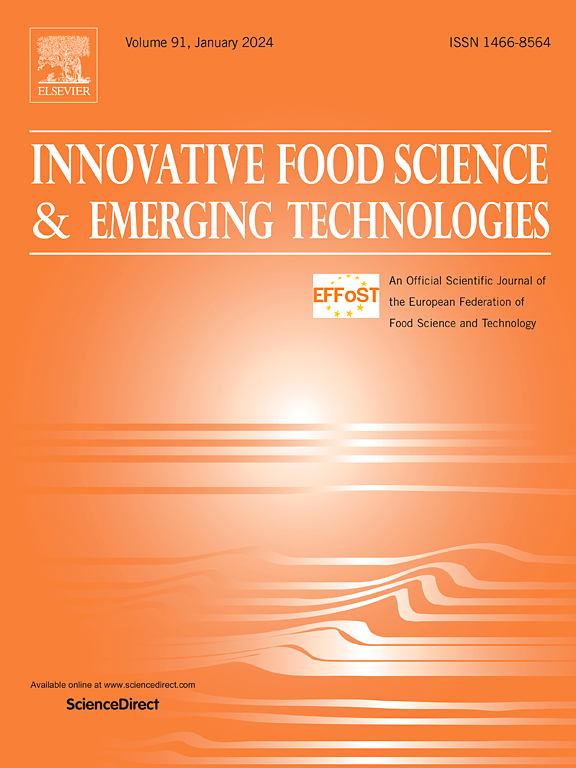Effect of smoke processing on the proteins and volatile compounds and their interactions in skipjack tuna
IF 6.3
1区 农林科学
Q1 FOOD SCIENCE & TECHNOLOGY
Innovative Food Science & Emerging Technologies
Pub Date : 2025-05-02
DOI:10.1016/j.ifset.2025.104035
引用次数: 0
Abstract
Characterizing the correlation between protein structure and flavor features is crucial for maintaining the quality of smoked skipjack tuna meat during freezing, heating, smoking, steaming, and slicing. This study provides a comprehensive analysis of protein structure, including sodium dodecyl sulfate-polyacrylamide gel electrophoresis (SDS-PAGE) and Fourier transform infrared spectroscopy (FTIR). The volatile flavor compounds (VFCs) were tentatively identified using Gas chromatography-mass spectrometry (GC–MS). Partial Least Squares Regression (PLSR) analysis was employed to demonstrate the correlation between VFCs and proteins. The results of free-sulfhydryl content and solubility analyses revealed that proteins underwent aggregation during the process due to the formation of disulfide bonds and cross-linking with smoke compounds. The results of SDS-PAGE further indicated that the proteins with molecular weights ranging from 45 to 140 kDa interacted with smoke compounds during the smoking stage. The FTIR results revealed that hydrogen bonding and hydrophobic interactions were the dominant factors in the processing. Except for the smoking stage, the thermal stability of skipjack tuna meat diminished in all processing stages. A total of 121 VFCs were identified, with phenols and pyrazines notably appearing during the smoking stage due to wood smoke decomposition. The PLSR analysis suggested that the free sulfhydryl groups are primarily responsible for the alterations in VFCs during the heating process, while changes in VFCs during smoking are mainly influenced by hydrogen bonding. The findings offer a comprehensive perspective on the alterations in protein structure that influence the formation of VFCs during processing, thereby expanding the applications of smoked skipjack tuna.
烟熏处理对鲣鱼蛋白质和挥发性化合物的影响及其相互作用
研究烟熏鲣肉在冷冻、加热、烟熏、蒸制、切片等过程中蛋白质结构与风味特征之间的关系,对保持烟熏鲣肉的品质至关重要。本研究利用十二烷基硫酸钠-聚丙烯酰胺凝胶电泳(SDS-PAGE)和傅里叶变换红外光谱(FTIR)对蛋白质结构进行了全面分析。采用气相色谱-质谱联用技术初步鉴定了挥发性风味化合物。采用偏最小二乘回归(PLSR)分析vfc与蛋白之间的相关性。游离巯基含量和溶解度分析结果表明,蛋白质在此过程中由于二硫键的形成和与烟雾化合物的交联而发生聚集。SDS-PAGE结果进一步表明,分子量在45 ~ 140 kDa之间的蛋白在烟熏期与烟熏化合物相互作用。FTIR结果表明,氢键和疏水相互作用是加工过程中的主要因素。除烟熏阶段外,鲣鱼肉的热稳定性在各加工阶段均有所下降。共鉴定出121种vfc,其中酚类和吡嗪类主要出现在冒烟阶段,这是由于木材烟雾分解造成的。PLSR分析表明,vfc在加热过程中的变化主要是由游离巯基引起的,而吸烟过程中vfc的变化主要受氢键的影响。该研究结果为在加工过程中影响vfc形成的蛋白质结构改变提供了一个全面的视角,从而扩大了烟熏鲣鱼的应用范围。
本文章由计算机程序翻译,如有差异,请以英文原文为准。
求助全文
约1分钟内获得全文
求助全文
来源期刊
CiteScore
12.00
自引率
6.10%
发文量
259
审稿时长
25 days
期刊介绍:
Innovative Food Science and Emerging Technologies (IFSET) aims to provide the highest quality original contributions and few, mainly upon invitation, reviews on and highly innovative developments in food science and emerging food process technologies. The significance of the results either for the science community or for industrial R&D groups must be specified. Papers submitted must be of highest scientific quality and only those advancing current scientific knowledge and understanding or with technical relevance will be considered.

 求助内容:
求助内容: 应助结果提醒方式:
应助结果提醒方式:


